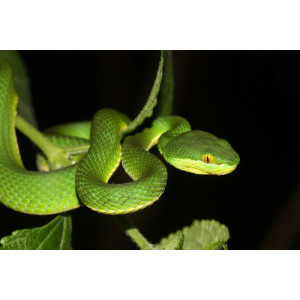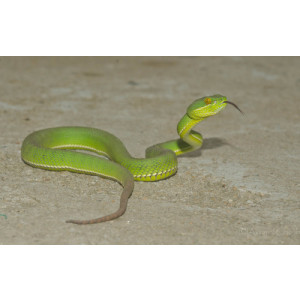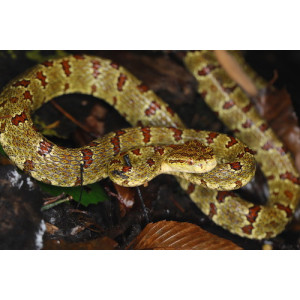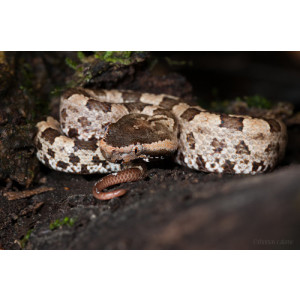Russell’s Viper Did you see this animal?
Scientific Name : Daboia russelii
Family : Viperidae
Order : Squamata
Class : Reptilia
Phylum : Chordata
Other Name : Indian Russell’s Viper,Common Russell's Viper
Habitat : Plainlands,Lowlands,Bushy areas
Description : Russell’s Viper are brown or brownish yellow in color. Their head is triangular in distinct from the body. A series of brown blotches are present in the body, each with black edges and run throughout the length of the body. Russell's viper is a terrestrial snake that is primarily active at night but becomes more active during the day in cool weather. They are slow and sluggish unless provoked, after which they can become very aggressive. When threatened, they form S-loops, hiss loudly, and can strike with great force. They do not have heat-sensitive pit organs but may still be able to detect thermal cues. Their supranasal sac contains nerve endings that resemble those found in heat-sensitive organs. Overall, Russell's vipers are strong and potentially dangerous snakes that should be treated with caution.
Russell's viper is ovoviviparous, with a gestation period of over six months. They mate early in the year, and pregnant females can be found at any time. Juveniles are typically produced from May to November, with litters of 20-40 being common, but as few as one or as many as 75 offspring in a single litter. Juveniles are 215-260 mm in total length at birth, and sexual maturity is achieved in 2-3 years. Gravid females have a minimum total length of about 100 cm. Giving birth can take several hours, with one specimen taking nearly 4.5 hours to deliver 11 young. Overall, Russell's vipers are prolific breeders that produce many offspring in a single litter.
Russell's viper primarily feeds on rodents, but will also consume small reptiles, land crabs, scorpions, and other arthropods. Juveniles feed on lizards and are active at dawn and dusk, while adults specialize in rodents and are attracted to human habitation where these prey species are abundant. Juveniles are known to exhibit cannibalistic behavior. According to a study published in The Lancet, 29% of individuals who survived bites from D. russelii experienced significant damage to their pituitary glands, resulting in hypopituitarism. Additional research has also provided evidence to support the theory that D. russelii bites can lead to hypopituitarism.
Russell's viper is ovoviviparous, with a gestation period of over six months. They mate early in the year, and pregnant females can be found at any time. Juveniles are typically produced from May to November, with litters of 20-40 being common, but as few as one or as many as 75 offspring in a single litter. Juveniles are 215-260 mm in total length at birth, and sexual maturity is achieved in 2-3 years. Gravid females have a minimum total length of about 100 cm. Giving birth can take several hours, with one specimen taking nearly 4.5 hours to deliver 11 young. Overall, Russell's vipers are prolific breeders that produce many offspring in a single litter.
Russell's viper primarily feeds on rodents, but will also consume small reptiles, land crabs, scorpions, and other arthropods. Juveniles feed on lizards and are active at dawn and dusk, while adults specialize in rodents and are attracted to human habitation where these prey species are abundant. Juveniles are known to exhibit cannibalistic behavior. According to a study published in The Lancet, 29% of individuals who survived bites from D. russelii experienced significant damage to their pituitary glands, resulting in hypopituitarism. Additional research has also provided evidence to support the theory that D. russelii bites can lead to hypopituitarism.
Distribution in Bangladesh
References:
description written by: Zarin Tasnim,Department of Zoology,University of Dhaka ; information source:IUCN Red List Bangladesh-2015 and www.reptile-database.reptarium.cz),z; photo credit:Yu Ching Tam (www.inaturalist.org/people/Yu Ching Tam). photo copyright: iNaturalist. more information please contact with us.
description written by: Zarin Tasnim,Department of Zoology,University of Dhaka ; information source:IUCN Red List Bangladesh-2015 and www.reptile-database.reptarium.cz),z; photo credit:Yu Ching Tam (www.inaturalist.org/people/Yu Ching Tam). photo copyright: iNaturalist. more information please contact with us.


































